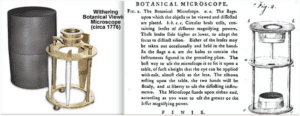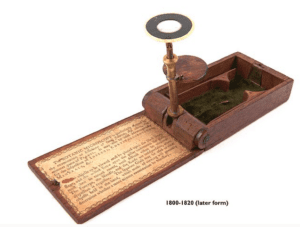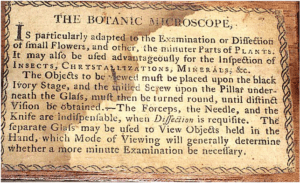JMS Pearce
East Yorks, Hull, England
 |
|
Fig 1. William Withering (left). Engraving by W. Bond after a painting by Carl Frederik von Breda, 1822. Public domain. Via Wellington Local Agenda 21 Group. Frontispiece colored illustration of foxglove from An Account of the Foxglove by William Withering (right). Printed by M. Swinney for G. G. J. and J. Robinson, London, 1785. Wellcome Collection via Wikimedia. Public domain. |
William Withering (1741-1799) (Fig 1) made several important contributions to medicine and science other than his well-known discovery of the medicinal value of the foxglove (Digitalis purpurea). Digitalis1 and diuretics were the lynchpins of treatment for edema and congestive heart failure until the 1990s. Withering found that if he used only the dried leaves gathered when the plant was about to flower, this would ensure uniformity of dosage and avoid toxicity. His other researches in medicine and science have received less attention.
William Withering was a physician, botanist, and mineralogist born in Wellington, Shropshire. His father Edmund was an apothecary, and his maternal uncle Brooke Hector was a physician. Little is known of his childhood. After graduating in medicine from the University of Edinburgh in 1766, he started practice in Stafford and helped to found the Stafford Infirmary.2 His botanical interests did not begin until 1767 when he helped a young patient, Helena Cookes, to search the local countryside for plants, which she was keen to sketch. Their relationship and his botanical interests flourished: when she came of age they married in September 1772, and had three children.
He moved to Birmingham in 1775 to practice and to fill a vacancy in the prestigious Lunar Society.3 His move was prompted by its foremost member, the polymath physician Erasmus Darwin, despite incondite arguments about priority of the discovery of digitalis. Together with Dr. John Ash, he served as a founder of the Birmingham General Hospital in 1779. His busy practice thrived; to the indigent, he gave his services free.
Withering’s botanical field microscope
 |
| Fig 2. Withering’s early microscope c. 1776. |
Withering gained renown for his botanical discoveries and writings. The first, following in the tradition of English naturalist John Ray, was his 1776 book A Botanical Arrangement of all the Vegetables Naturally Growing in Great Britain, which became the standard text for many years. He was the first to use Carl Linnaeus’s system to classify systematically the flora of Great Britain. However, in order to protect female modesty, he omitted references to sexual reproduction. His An Arrangement of British Plants (1787–92) further sought to demonstrate Linnaean applications to botany. The genus Witheringia solanacea (a physalis native to Mexico and South America) was named after him. He was elected a Fellow of the Linnean Society — the world’s oldest society devoted to natural history — in 1789.
In An Arrangement of British Plants, he described his specially designed field microscope, which subsequently became known as the Withering botanical microscope. Now largely forgotten, it was designed to examine plants, insects, crystals, and minerals.
More powerful simple and compound desk microscopes already existed, such as those of Hans and Zacharias Janssen (circa 1600), Antoni van Leeuwenhoek (1670-1675), and Robert Hooke’s compound microscope (“Micrographia” 1665).4 They were put to good use inter alia by Robert Boyle, Isaac Newton, Nicholas Culpeper, Arthur Hill Hassall, Rudolf Virchow, and Theodor Schwann.
 |
| Fig 3. Withering’s later microscope 1800-1820. |
Withering’s original botanical microscope is described and photographed in Gerard Turner’s 1981 book Collecting Microscopes. Those keen to explore natural flora and fauna would carry them in their pockets on their travels. His early microscopes (Fig 2) were housed in a cylindrical leather or shagreen case. He made several modifications (Fig 3). Instructions were included (Fig 4).
The original one (c. 1785) had three pillars. There was a lens at each end for different magnifications and a single slot for small tweezers. An ivory version had two supports rather than three, and focus was by moving the stage, adjusted by a milled screw on the pillar. Later adaptations included a mirror below the stage for viewing transparent objects and a single pillar replaced the original three pillars. Some were boxed in mahogany with a green velvet lining, a glass lens mounting of ivory, and the pillar and limb made of brass often on a black ivory stage. Conveniently, from about 1790, the case when opened automatically erected the microscope; when closed, the stage and lens automatically folded neatly inside (Fig 3). The closed box measured about 30 mm x 125 mm x 65 mm.
The original handsomely crafted instrument viewed only opaque objects and had three supports. In improved versions there was a lens at each end for different magnifications, which though hampered by chromatic and spherical aberrations (subsequently corrected by Joseph Jackson Lister — father of the famous surgeon Lord Lister), were capable of magnifying specimens between three and five times life-size. Accessories included two bone handle iron scalpels and tweezers or forceps and a separate hand lens.
 |
| Fig 4. Description of the botanic microscope. |
He created several improved variations over the next few years, and though their magnification was low, they proved very popular for field work. They are now rare antiques, replaced by sophisticated, lightweight, portable instruments with much greater (20-120+) magnification, some with battery-operated lighting.
Withering also had an interest in mineralogy and was elected a Fellow of the Royal Society in 1785 for his paper Experiments and Observations on the Terra Ponderosa, an ore from which he extracted barium carbonate. It was later renamed Witherite by the mineralogist AG Werner. A rare mineral that is only found in a few locations, Witherite is used in Josiah Wedgwood’s acclaimed Jasperware, and in hardening steel, and in glassware.
He was active in both the Society for Promoting the Abolition of the Slave Trade and in the Lunar Society. He suffered repeatedly from fever and respiratory symptoms with hemoptysis, which he attributed to consumption (tuberculosis), and eventually died in 1799. He was buried in Edgbaston Old Church. His monument is ornamented with the foxglove. His blue plaque is at Edgbaston Golf Club, sited at Edgbaston Hall, his former home. The annual William Withering Lecture and the William Withering Chair in Medicine at the University of Birmingham hallow his name.
References
- Aronson JK. An account of the foxglove and its medical uses, 1785–1985. Oxford University Press. 1985.
- Peck TW, Wilkinson KD. William Withering of Birmingham MD. FRS. FLS. Bristol: John Wright and Sons. 1950.
- Pearce JMS. The Lunar Society legacy. Hektoen Int. Summer 2014.
- Lawson I. Crafting the microworld: how Robert Hooke constructed knowledge about small things. Notes & Records, Royal Society Journal of the history of science; 2016:70:23–44.
JMS PEARCE is a retired neurologist and author with a particular interest in the history of science and medicine.
Winter 2022 | Sections | Physicians of Note

Leave a Reply